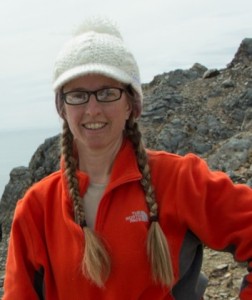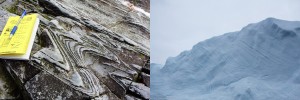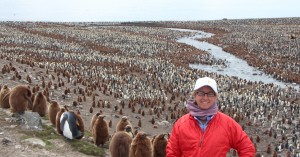March 6, 2013
 Sustainability student travels to Antarctica; experience to benefit military professorship career
Sustainability student travels to Antarctica; experience to benefit military professorship career
Mindy Kimball is the type of person who lives and breathes what she loves. When she was little, it was rocks. That same passion turned into a career in geology. As an undergraduate student she studied environmental science, and her master’s thesis was on locating earthquake faults.
“I was always interested in rocks and always thought rocks were cool,” Kimball says. “I just never grew out of them.”
Her geology background came in handy as a Space Operations Officer for the U.S. Army. She paid attention to any intergalactic happenings (like solar flares and satellite malfunctions) that could interfere with the Army’s communications or military plans. If a commander wanted to move a satellite, it was Kimball who had to tell them to wait until Earth rotated enough so the satellite could be in the right position.
Kimball's military service entitles her to education benefits. The Army is supporting her doctoral education in sustainability at Arizona State University’s School of Sustainability. Due to her flexible graduate student schedule, she was able to join an expedition to Antarctica with the Geological Society of America (GSA).

Scientists on the trip were amazed by the similarities found between a metamorphic rock (left) and a metamorphic iceberg (right). Picture by Mindy Kimball.
The trip
To celebrate its 125th anniversary, the GSA organized geologists, scientists, and biologists to lead lessons during the expedition. Starting at the Falkland Islands, Kimball and the other passengers boarded the ship, Akademik Ioffe, a converted Russian research vessel that is now used for eco-tourism.
Kimball chronicled the trip on her blog, Mindy’s Antarctic Adventures. From penguins to giant “snake-like” leopard seals, Kimball observed the local wildlife, and learned about iceberg formations and whale species identification.
Kimball’s experiences and those of her fellow passengers contributed to larger scientific studies. Photographs of diving whales were given to a research center in Maine, and will be catalogued in its database of whale migrations. Kimball’s observations and photographs of a unique iceberg may inspire a fellow scientist’s academic paper on iceberg measurement methodology. A fundraising event during the expedition collected over $30,000 that will be used for invasive rat eradication and native bird habitat restoration on South Georgia Island.
Adventure applied to real life
Kimball plans to use her experience in Antarctica in her future professorship at the United States Military Academy at West Point in New York. She will be teaching her undergraduate area of expertise: environmental science. She can share the science she witnessed first-hand in Antarctica with Army cadets at West Point.
“It’s always more believable to say ‘I’ve been there; I’ve seen the glaciers melting; I’ve seen the whaling impacts on wildlife,’” says Kimball. “I can talk about what we always teach, but now I can actually show how the science happens.”

Kimball at St. Andrews Bay in the South Georgia Islands. And behind her, a colony of about 200,000 pairs of King penguins!
The most important lesson
Kimball joined Arizona State University’s School of Sustainability to broaden her environmental science background. The School is part of ASU’s Global Institute of Sustainability.
“I saw what was going on in the School of Sustainability and the unique approaches the School had. That gives me an edge going back into academia,” she says. “I get the environmental science stuff; I get the geology stuff; I can teach those classes already. But now I can talk about the implications of these sciences.”
And it’s those moments of discovery—like the iceberg moonlighting as a rock formation, or the region’s geography that changed over 40 years—that keep Kimball passionate about teaching.
“Those moments of discovery—when you see the light bulb go on when a student is figuring out how something works—that is so rewarding,” she says. “I love being able to share those moments of discovery with other people.”
One important lesson Kimball learned during the Antarctica expedition is one she hopes to take to her job at West Point.
“What I took away from the trip is how fun it is to never stop learning,” she says. “If you continue to be interested in something and that’s your passion, then you should always keep at it.”
By Natalie Muilenberg
Editor Assistant, Global Institute of Sustainability

